Movies featuring creatures and monsters have only one certain inevitability, and that is Death. More often than not, it’s not the central characters that get the knife (plot armor is rampant). Instead, it's some poor, unsuspecting soul who doesn’t even get a chance to draw breath before their life is very brutally snuffed out. These trailblazing victims unknowingly stumbled into the clutches of terrifying creatures. They set the tone and backdrop against which the rest of the movie unfolds, foreshadowing the chaos to come.
Remember that petrifying opening scene in A Quiet Place with young Beau Abbott? Or Beni’s panic-stricken betrayal in The Mummy, where switching sides couldn’t save him from the wrath of Imhotep? They were never meant to stay till the credits rolled and were caught existing in the wrong place at the wrong time.
Their brief, brutal trajectories on screen may have sealed their fate, but they made sure we stayed on the edge of our seats. Buckle up as we revisit the first of the fallen from some of the most thrilling creature chronicle movies ever made. Their time was short, but their impact? Strikingly memorable.
Beau Abbott in the movie: A Quiet Place (2018)
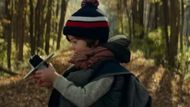
In the nightmare setting of the movie A Quiet Place, survival means one thing: stay silent, or die. But the tragic loss of little Beau Abbott showed just how rapidly the stakes can turn fatal. His death was not only shocking but was a flawless opening gut punch that set the brutal tone for the entire course of the movie.
As Lee and Evelyn Abbott walked through the deserted town with their three children, being silent wasn’t just a necessary precaution. It was the thin line that separated life from death. But Beau, a curious little boy, held a battery-operated toy rocket that hummed to life at the most ill-fated moment.
The horrified faces of the family said it all as the sightless creatures, hypersensitive to sound, pounced in a flash, and Beau was gone in the blink of an eye. Lee’s failed attempt to save his son in this slow-motion sequence is one of the most heart-stopping shots in recent creature chronicle movies. Beau’s death setting the stage for the rest of the characters in the movie.
Bernard Burns in the movie: The Mummy (1999)
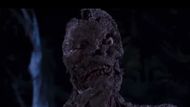
In Stephen Sommers’ The Mummy (1999), Brendan Fraser’s rough and charming Rick O’Connell brought adventure and humor to the big screen. But it was Bernard Burns, portrayed by Tuc Watkins, and his three other ‘friends’ who earned the misfortune of being the Mummy’s first victims.
Burns was part of an excavating crew hunting for treasure that cracked open the cursed sarcophagus, unleashing Imhotep’s wrath. In the darkness of Hamunaptra’s dusty tomb, Burns scrambled to escape, but the misfortune of his glasses shattering sealed his fate. As the cursed high priest Imhotep awakened, Burns was cornered, and his eyes—as much as they could see—were wide with terror. His howls resonated piercingly as his tongue and eyes were gouged out by Imhotep, spiraling his deadly curse into motion.
Hawkins in the movie: Predator (1987)
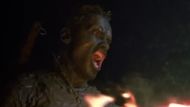
The Predator movie was set against the scene of the American jungle. The perilous terrain wasn’t just home to foreign guerrillas, but also to one of the most technologically advanced alien humanoids. Shane Black’s character, Hawkins, was the first among Dutch’s elite team to fall into the clutches of the cloaked Predator.
Known for his crude jokes and expertise with radio, Hawkins met his gnarly finish when he strayed a little too far into the jungle. He was trying to capture Anna, a surviving guerrilla who had escaped. One second, he was nervously grasping his rifle, and the next, he disappeared—dragged away by an invisible force.
The Predator’s trademarks—its methodical stalking, distorted clicking, and the splash of bright green blood—were instantly iconic. These elements would go on to forge a lasting saga in the world of creature chronicle movies. It all began with Hawkins’ demise.
Luis and Tomas in the movie: Creature from the Black Lagoon (1954)
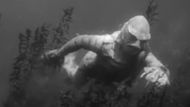
The movie Creature from the Black Lagoon explores the silent foreboding lingering beneath the Amazon. The first victims? Poor Luis and Tomas, Dr. Carl Maia’s two assistants and expendable members of the initial geology team.
After a geology expedition uncovers strange fossilized remains from the Devonian period that suggest a direct link between land and sea animals, a mystery begins to unfold. It gives rise to one of the best haunting plots in movie history. As the two scientists explored the mysterious lagoon—after Carl left them in charge—a real, living piscine amphibious humanoid, intrigued by the camp where Luis and Tomas were staying. It quietly attempts to stalk them. However, doing so poorly, the creature is noticed by the two scientists, and its sudden appearance frightens them. The creature panics in turn, and in a moment of anxious anger, kills both Tomas and Luis.
Realizing they had awakened a prehistoric nightmare, the main characters try to fix their mistakes. However, the damage was already done. These deaths weren’t just the start of the violence, but a warning for the meddling outside world to stay away.
Jophery Brown in the movie: Jurassic Park (1993)
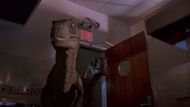
Spielberg’s Jurassic Park reimagined the genre while also granting us one of the most outstanding opening deaths in cinema history. The movie begins with a velociraptor feeding gone disastrously wrong. The first victim being Jophery Brown, a dinosaur handler in a Jurassic theme park on the tropical island of Isla Nublar.
As the raptor’s cage is being secured, things spiral out of control. The beast lunges, pulling Jophery into the cage as the rest of the park’s workers frantically shout to shoot the raptor. All of it plays out in the first few minutes of the movie, in such a horrific way that it is now etched into pop culture memory forever.
The panic and chaos set the stage for the film’s core message: that trying to cage or control nature is nothing but man playing god. Such conceptions have never led to glory, only destruction.
The crew members in the movie: Godzilla (1954)
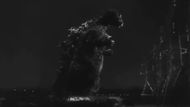
Before making it to the streets of Tokyo, the first Godzilla movie used the uncharted secrets of the sea as its choice of an eerie setting.
During a hazy night, the crew of the Eiko-Maru, a Japanese freighter, experiences a disturbance, followed by a blinding flash that lights up the ocean. A devastating roar follows, and seconds later, the boat is obliterated. The men aboard had no backstories or plot arcs—just ordinary, nameless workers swallowed by an ancient force awakened by mankind’s own nuclear folly.
Director and co-writer Ishirō Honda used their deaths as a harrowing statement. These lost fishermen were the first victims of the atomic age monster. Their corpses were never found, their screams drowned beneath the waves. This moment left a powerful impact, inspiring a numbing fear that something ineffable had been let loose. Their deaths weren’t just a plot device but a metaphor for the innumerable, faceless casualties of real-life nuclear disasters in Japan. Unlike the more dramatic deaths in the Godzilla franchise, this one felt especially hard-hitting.
Kane in the movie: Alien (1979)
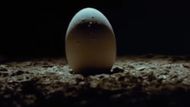
In Ridley Scott’s Alien, the first official victim is attacked by a creature unlike any monster the world had seen.
The crew of the Nostromo, led by Dallas and Ripley, is lured to a distress signal on a nearby planetoid. Executive Officer Kane, played by the brilliant John Hurt, becomes the unwilling host to a creature that would redefine sci-fi horror forever. It starts with the mission as Kane explores the derelict alien ship and stumbles across a chamber containing hundreds of large alien eggs. He barely touches one when a spider-like creature springs out from it, penetrating his helmet and attaching itself to Kane’s face.
After he’s brought back to their ship, Ash attempts to remove the creature from his face but is unsuccessful. However, a little later, the alien mysteriously detaches itself, and Kane seems to have recovered. But the movie is just getting started. In a moment of pure shock, as the crew is having their last meal before they return to stasis, Kane suddenly chokes and convulses madly. A small alien creature bursts from his chest, killing him and escaping inside the ship—leaving his crew petrified with dread.
Kane’s horrid demise is a pivotal moment, establishing the ‘Xenomorph’ trope.
Chrissie Watkins in the movie: Jaws (1975)
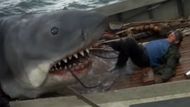
Spielberg’s iconic movie Jaws from the ’70s didn’t wait long to grab us by the throat—quite literally. The movie starts with Chrissie Watkins, a beachgoer played by Susan Backlinie, who runs toward the water under the glimmering moonlight.
What starts as a playful midnight swim becomes one of cinema’s scariest death scenes. The camera lurks beneath the water, giving us the infamous shark-eye view. Chrissie’s laughs abruptly come to a halt as something seems to pull her violently underwater.
She wails, writhing in agonizing pain, but her companion ashore—too inebriated to act—is useless. Chrissie’s pleas fade into silence as she is dragged under in a final, bone-chilling gulp. The next morning, only parts of her remain, washing up on Amity Island’s shores.
Backlinie’s raw, unscripted panic sold the scene with brutal authenticity, making her death a defining warning. Her end didn’t just jump-start the story—it ignited a lasting fear of the ocean that lingers even decades later.
The Norwegian man in the movie: The Thing (1982)
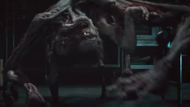
This John Carpenter movie is a masterclass in creating visual psychosis. Doom arises not with a brutal death but with a chaotic chase across the frozen landscape of Antarctica.
The first on-screen casualty is a frantic Norwegian helicopter gunner who crashes into the American research base, firing wildly at an innocent-looking sled dog. His words are lost to the Americans, but unbeknownst to them, the Norwegian man’s shouts aren’t just screams—they’re warnings. But since none of the Americans spoke Norwegian, all they saw was a man who had lost his mind.
Garry, the station commander, pulls his revolver and fires, killing the Norwegian in cold, bewildered confusion. Garry’s shot marks the first human death, but the real first victim? It was the Norwegians’ truth—silenced by language, fear, and a lack of context. The sled dog, which seemed docile and harmless, carried within it a shape-shifting alien organism that waits, ready to consume, imitate, and destroy.
The Norwegian’s death isn’t bloody or monstrous. It’s tragically overlooked. Carpenter’s The Thing doesn’t deliver its first victim with a jump scare, but with a bullet to the heart and a world-shattering misunderstanding. In a film where identity can be stolen and monsters wear the faces of your friends, the first death is a man desperately trying to tell the truth.
And nobody listened.
Jonas' crew members in the movie: The Meg (2018)
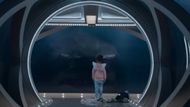
When a nuclear submarine vessel is crippled and stranded, rescue diver Jonas Taylor is handed the mission of saving them. However, he sees something that has him crippled with fear: the prehistoric megalodon.
Jonas is forced to abandon his attempt to save every member of the crew and flee. Trying to rescue the remaining two crewmembers would have resulted in the deaths of everyone else they had managed to save. Jonas recollects the incidents of that ill-fated day clearly. However, his claim that he saw a giant extinct shark is dismissed by everyone, and he becomes a laughingstock among his peers.
These unnamed characters are presumed to be the very first victims of the ancient sea creature. Unlike Jaws, The Meg thrives on scale and spectacle. The deaths may be grand, loud, and cinematic—but it is a thrilling watch.
Love movies? Try our Box Office Game and Movie Grid Game to test your film knowledge and have some fun!
